F. Units’ Responses to Surging Enrollments
The CRA Enrollment Survey asked a wide range of questions about the impact of increased enrollment in undergraduate courses on the units[1], including questions on what was or may be reduced, what was or may be eliminated, how the increased demand is managed, and what units are trying to maintain and preserve. This section summarizes the responses on the actions taken or not taken by the 134 doctoral- and 93 non-doctoral granting units that completed the survey. The complete list of questions asked in the CRA Enrollment Survey is available from a link within [H. Methodology]. We encourage the reader to see the survey for the full wording of the questions.
The CRA survey asked units to assess the impact of their increased enrollments and the demand on associated resources. The following sections summarize responses on actions taken to manage enrollment growth, course size, related resources, and faculty workloads. We also report on approaches taken to manage students’ access to courses.
General Enrollment Management Strategies
The survey asked units to rate eight actions representing possible reductions explicitly taken or in process to manage the enrollment growth. Figures F.1(a) and F.1(b) list the responses that were received from the doctoral- and non-doctoral granting units. We list the actions by the largest responses for “Reduced” in doctoral-granting units. For the doctoral-granting units, more than 50% of units stated they have reduced or plan to reduce two of the actions listed: reducing the number of courses with low enrollments and reducing the number of electives offered. For the non-doctoral granting units, more than 50% of units stated they have reduced one of the actions listed: the units’ contribution to the College Core or First Year program. The difference in responses is likely due to differences in priorities and institutional structures.
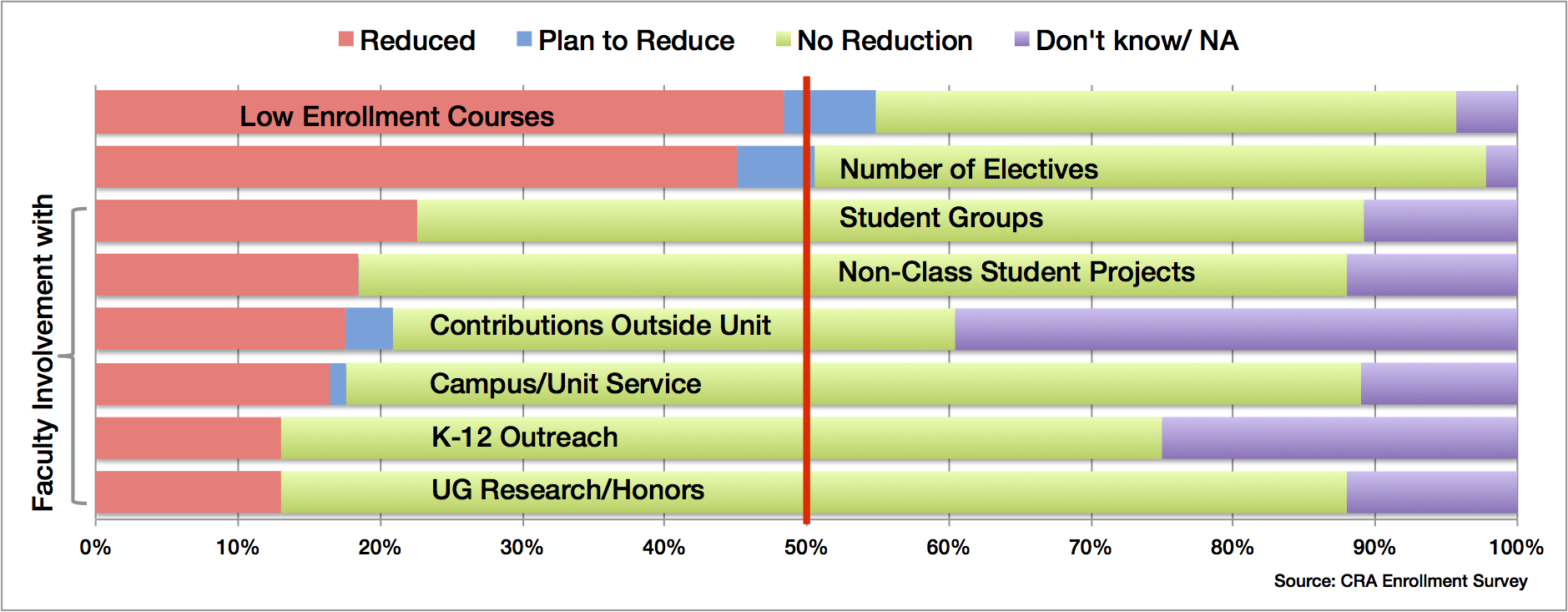
(a) Doctoral-Granting Units
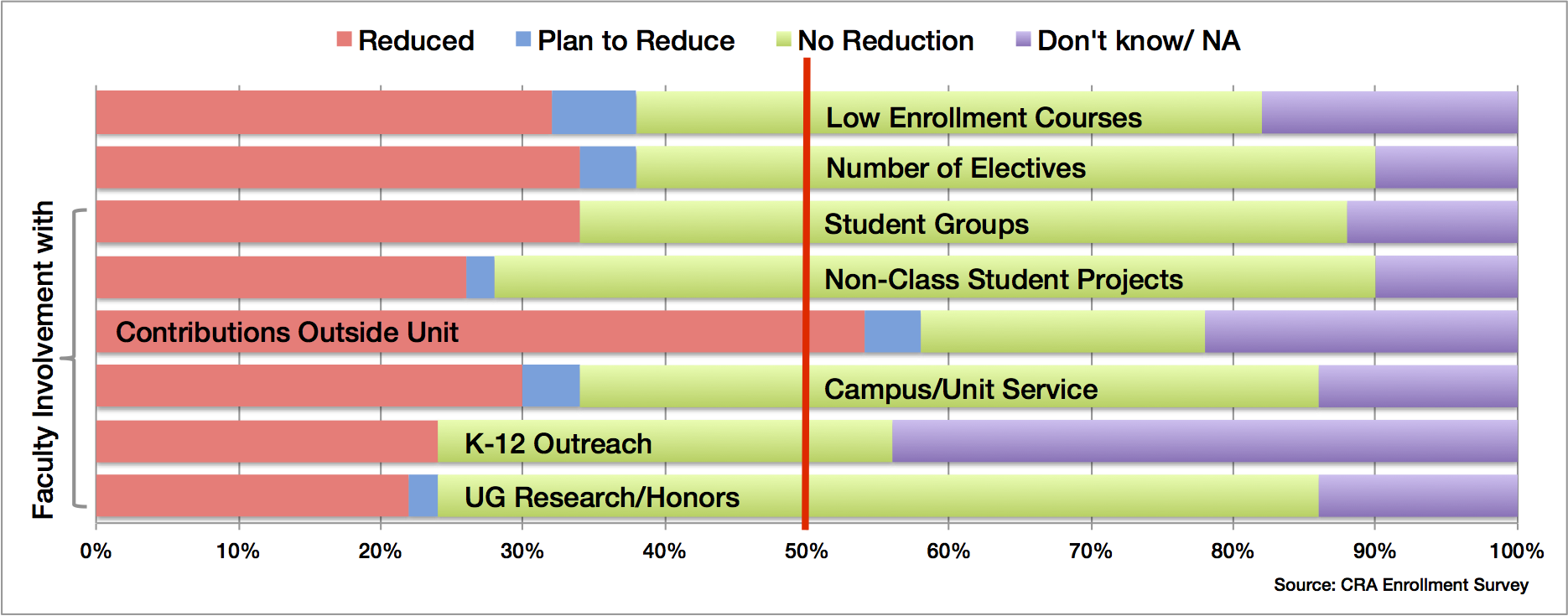
(b) Non-Doctoral Granting Units
Figure F.1: Enrollment related actions taken by units
Actions Taken to Manage Course Size and Student Enrollment
Figures F.2(a) and F.2(b) list possible actions related to managing course size and enrollments. The survey asked units to rate each action using six criteria, from “Done this” to “Don’t know/NA.” We list the actions by the largest responses for “Done this” in doctoral-granting units.
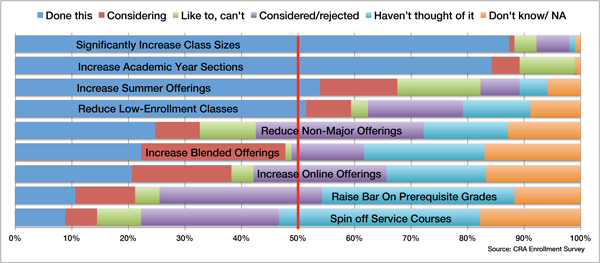
(a) Doctoral-Granting Units
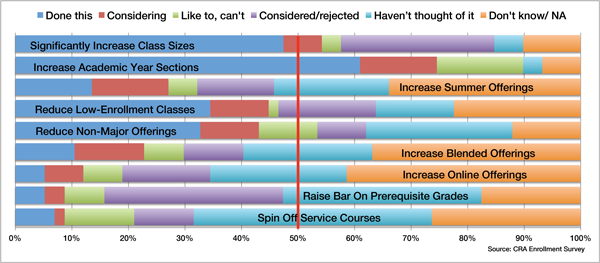
(b) Non-Doctoral Granting Units
Figure F.2: Actions taken to manage course size and enrollments
The top two actions taken by both doctoral- and non-doctoral granting units to manage increased course size and enrollment are not surprising: increasing the number of sections and significantly increasing class sizes. More than 80% of the doctoral-granting units and 47-61% of non-doctoral units have already taken these two actions.
More than 50% of the doctoral-granting units are offering extra summer courses, while few of the non-doctoral granting units are employing this strategy. More than 50% of the doctoral-granting units and 34% of the non-doctoral granting units have also reduced the number of low enrollment courses offered. Less than 11% of the units stated that they have raised the bar for doing well in a course, so fewer students advance in the program. In fact, raising the bar and spinning off service courses to other units are the two course management strategies that have been done or are being considered by the fewest units.
Actions Taken to Manage Teaching Resources
Figures F.3(a) and F.3(b) show how units are managing their teaching resources in response to the growth in student enrollment. For each action, “Done this” means the units have increased their use of the specified action.
The top four actions already taken by more than 65% of doctoral-granting units are increasing: (1) the use of existing undergraduate TA programs, (2) the use of adjuncts and visitors, (3) the use of advanced graduate students to teach courses, and (4) the number of teaching faculty. The two largest actions already taken for managing teaching resources at the non-doctoral granting units are an increased reliance on adjuncts and visitors (44%) and beginning a new undergraduate TA/tutor program (45%, which is the same level of response for this action from doctoral-granting units).
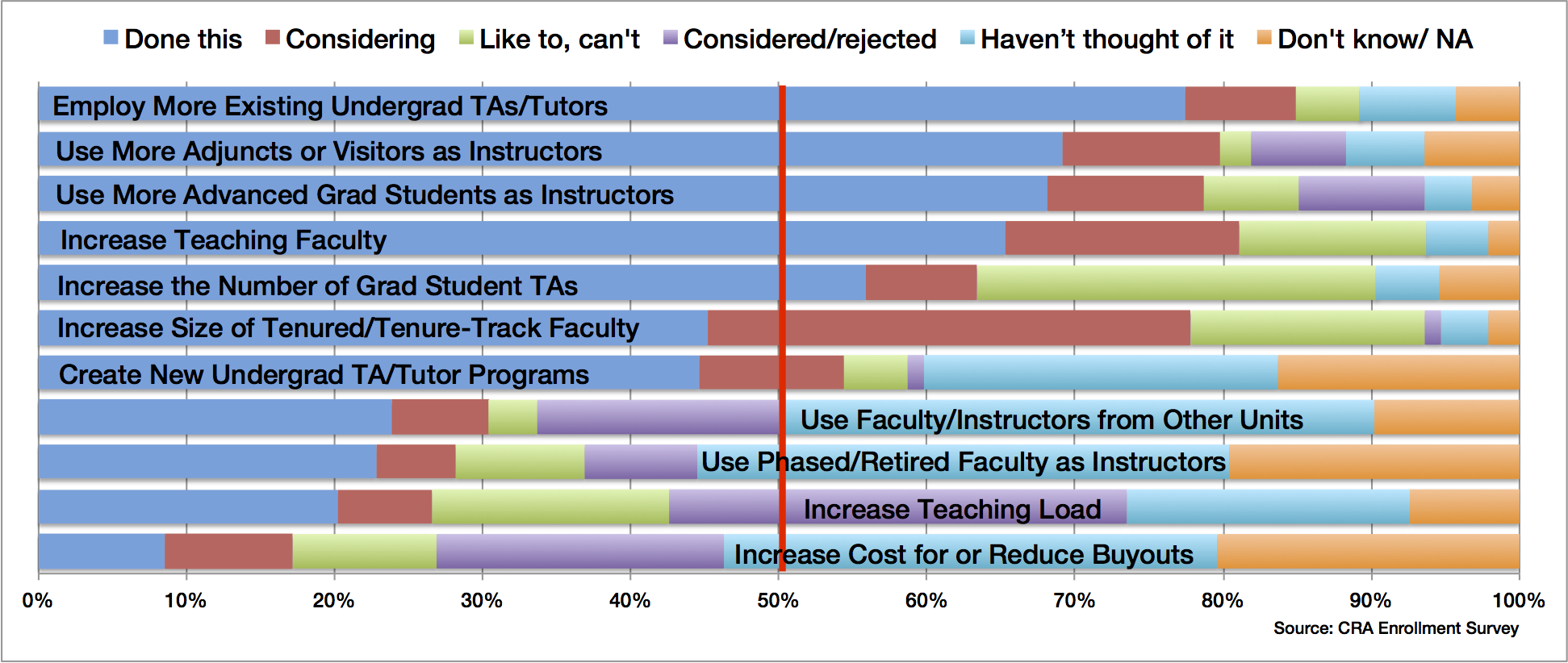
(a) Doctoral-Granting Units
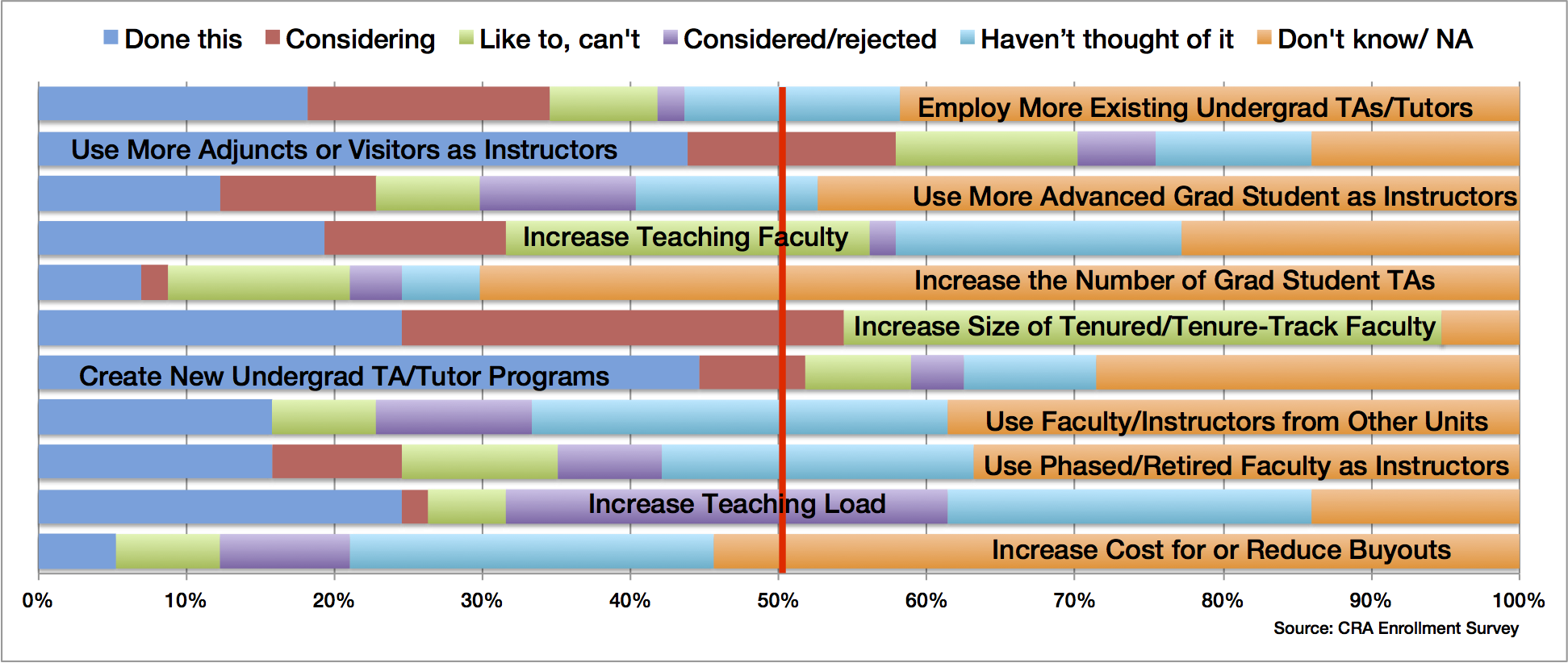
(b) Non-Doctoral Granting Units
Figure F.3: Actions taken to manage teaching resources
The two most rejected or not-allowed actions at doctoral-granting units include increasing teaching loads and modifying the administration cost of teaching buyouts. A number of the possible actions listed in the survey are not applicable for many non-doctoral granting units, making it difficult to interpret the most-often rejected actions by these units. Similar to doctoral-granting units, a notable number of non-doctoral granting units (25%) have increased the teaching loads of their faculty. A slightly larger percent have considered this action but rejected it.
In both doctoral- and non-doctoral granting units, the largest “Considering” action to manage teaching resources is hiring tenured/tenure track faculty. The sharp increase in the number of open tenure-track faculty positions at both doctoral- and non-doctoral granting units suggests that units are having difficulties filling open positions[2]. Since only about one-third of new Ph.D.s pursue an academic position[3] and industry continues to hire researchers from academia[4], filling open faculty positions will continue to be a challenge.
Managing Faculty Workloads
Figures F.4(a) and F.4(b) show actions that units are taking to manage faculty workloads. For doctoral-granting units, the responses are diverse and no action was taken by more than 50% of the units. Approximately 50% of the units are not using junior faculty in large classes and are accepting that increased workloads are a fact of life. Indeed, more than 60% of both doctoral- and non-doctoral-granting institutions units reported they are accepting or beginning to accept the increase in workloads as a “new normal.” Few units have thought of eliminating or reducing service workloads, providing additional compensation, giving more credit for teaching in annual performance reviews, or training faculty in scalable class management.
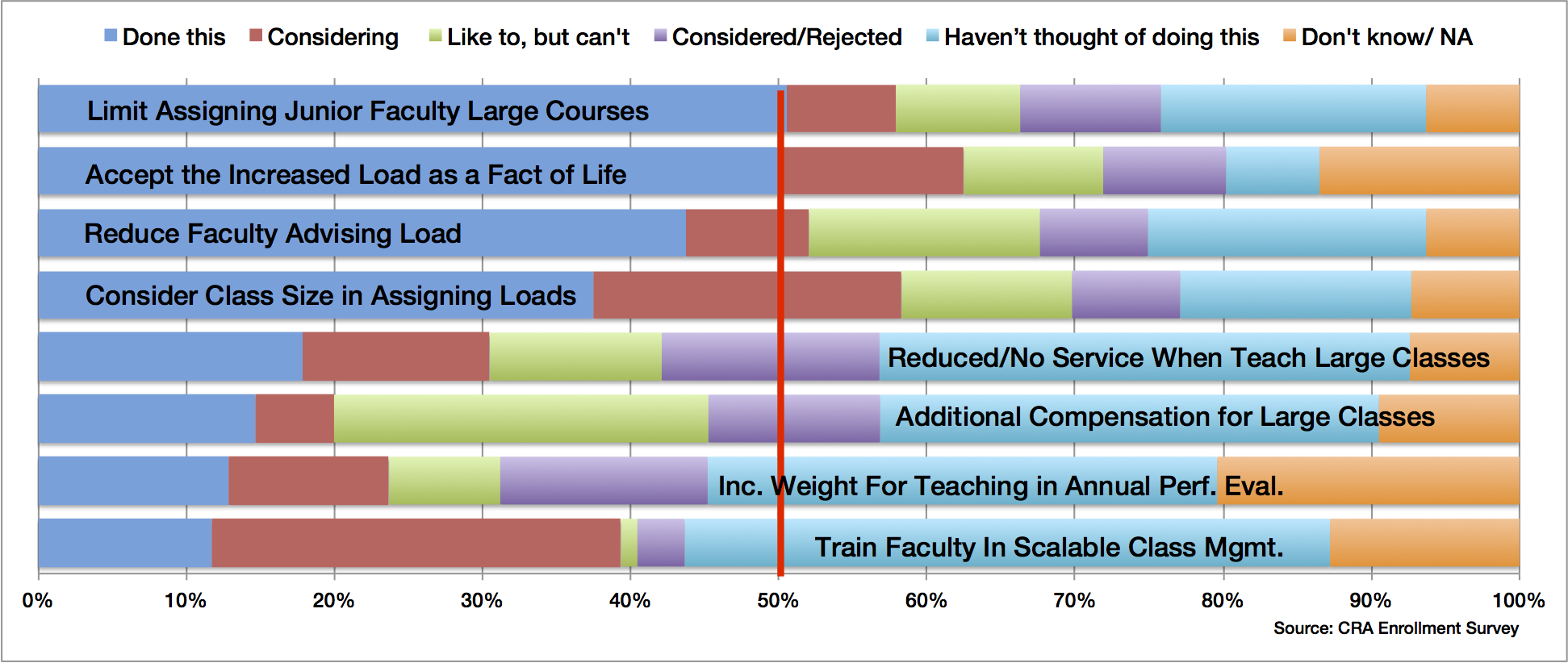
(a) Doctoral-Granting Units
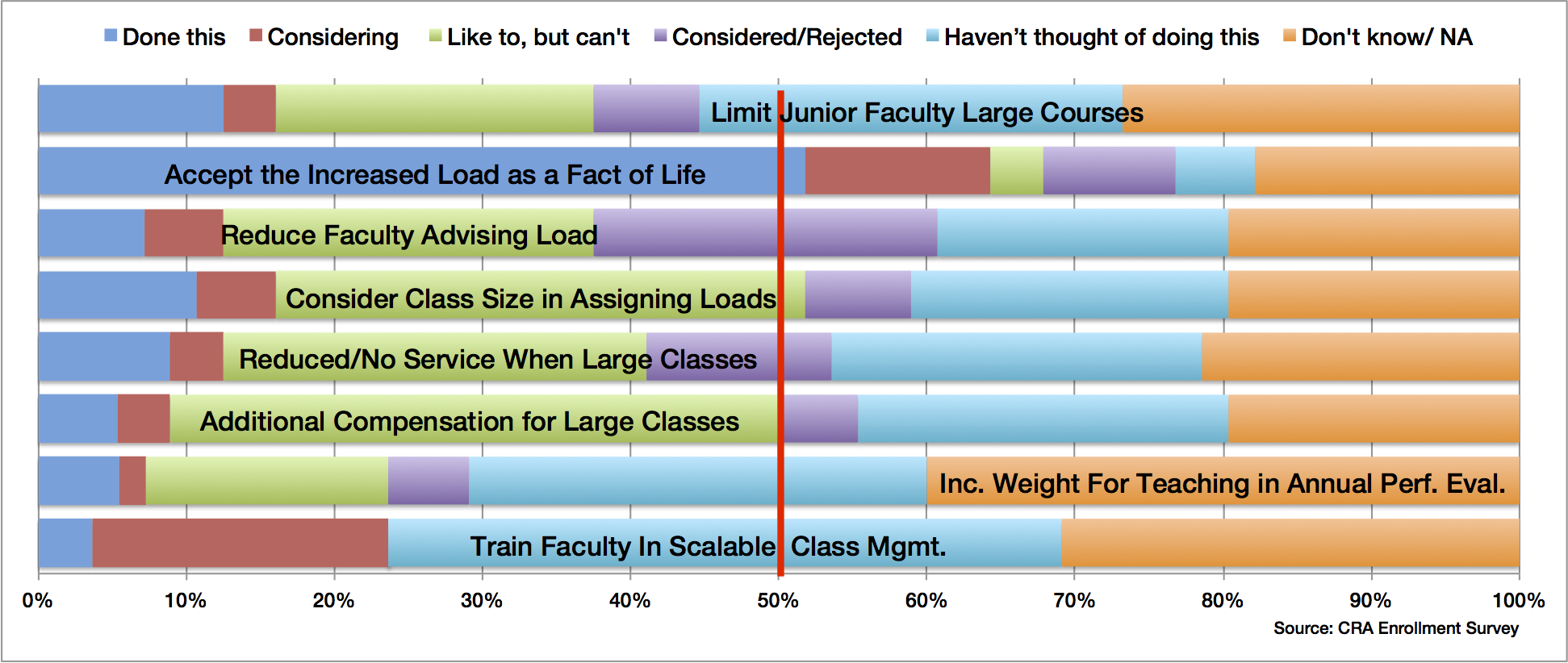
(b) Non-Doctoral Granting Units
Figure F.4: Actions taken to manage faculty workloads
Managing Students’ Access to Courses
Figures F.5(a) and F.5(b) show responses to five questions related to restricting admission to the major and limiting enrollment in courses. Close to 50% of both doctoral- and non-doctoral granting units limit enrollments in high-demand courses. More than one-third of both doctoral- and non-doctoral granting units also advise less successful students to leave the major. Doctoral-granting units are more likely to require that students are a major or minor in order to enroll in an advanced course (i.e., 45% of doctoral-granting units have put restrictions on non-majors/minors to enroll in advanced courses while only 16% of non-doctoral granting units have done this).
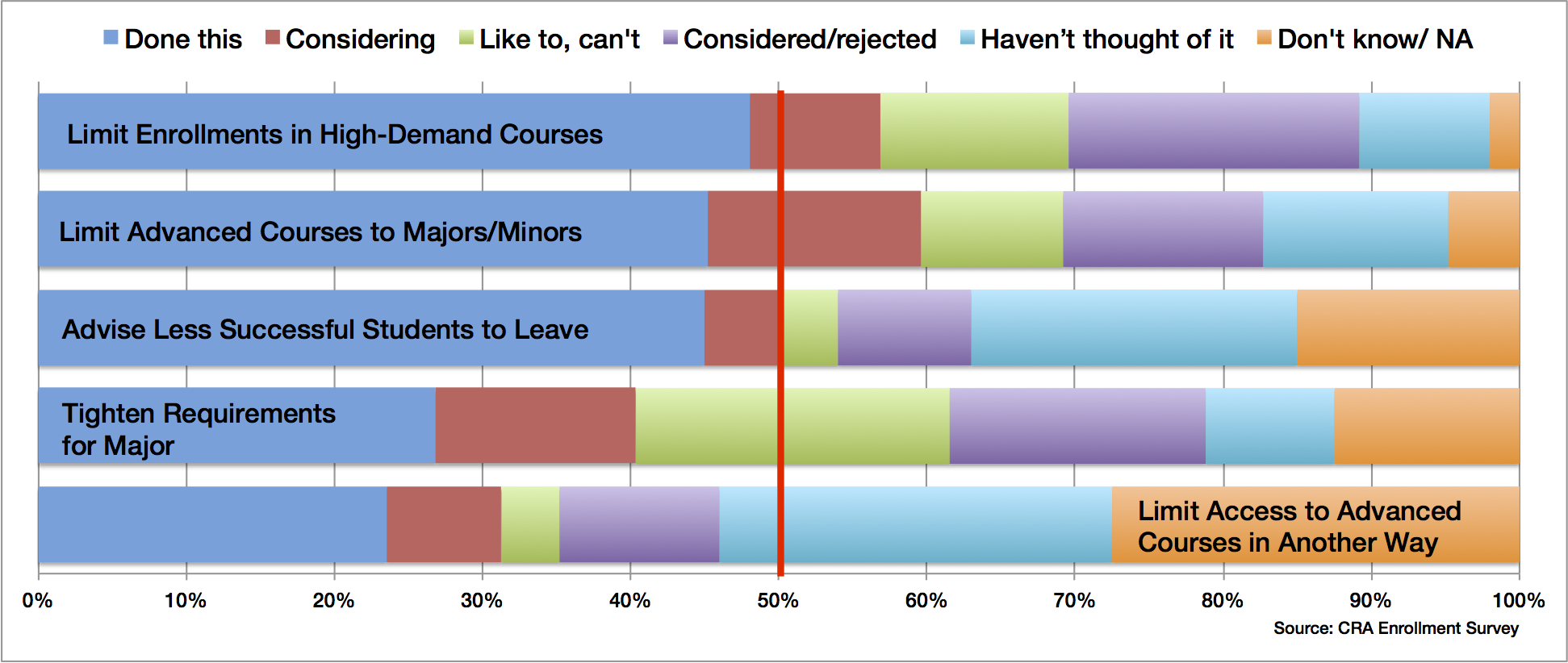
(a) Doctoral-Granting Units
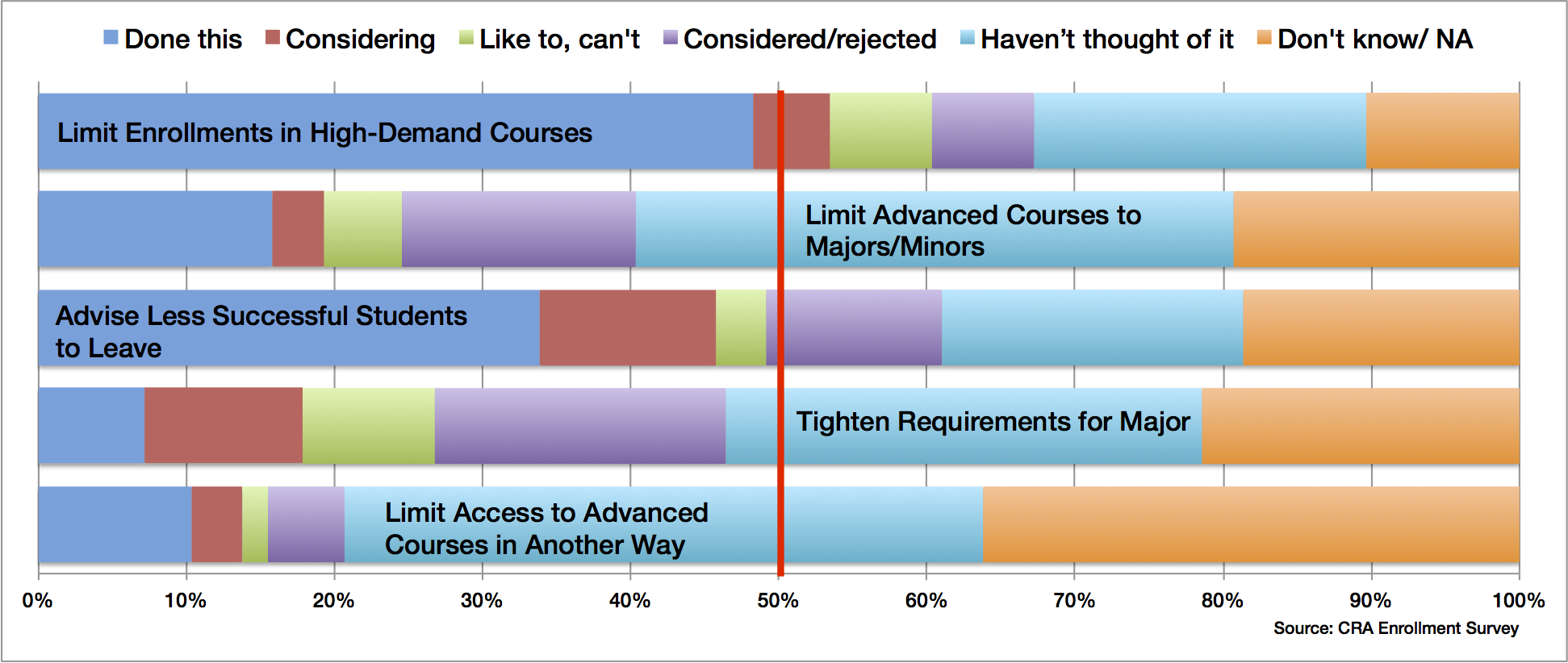
(b) Non-Doctoral Granting Units
Figure F.5: Actions taken to manage access to courses or major
Doctoral granting units are also more likely than non-doctoral granting units to tighten requirements for their major (27% vs. 7%). Almost 40% of doctoral- and almost 30% of non-doctoral granting units report that they could not or rejected the idea of tightening requirements for entering the major. Lastly, the responses shown in Figure F.5(b) suggest that non-doctoral granting units have not explored some of actions that doctoral-granting units have already implemented.
There is a great deal of research[5] that discusses how actions taken by a department (e.g., to manage access to courses or a major) have an impact on diversity. For an in-depth discussion about diversity, see [D. Impact on Diversity]. In conclusion, units should think carefully about the impact of their actions to manage students’ access to CS courses.
Summary
The responses to the CRA Enrollment Survey clearly show that both doctoral- and non-doctoral granting units are experiencing significant increases in undergraduate course enrollments. Units are using or are planning to use a wide range of approaches to manage student enrollments, manage enrollment-related resources, and reduce the demands on faculty while trying to meet the needs of both majors and nonmajors.
As units continue to manage increasing enrollments, a number of the actions taken or not taken could cause undesirable results. Offering courses in continuously larger classrooms lacks scalability. In addition, ever-increasing class sizes may reduce the quality of the students’ education and make teaching less attractive to faculty. The survey results show that one consequence of increased enrollments is faculty reducing their involvement in valuable non-course related educational activities.
Given the available data on job postings, Ph.D. production, and the insufficient number of new Ph.D.s pursuing academic positions, units may not be able to hire faculty members as planned. In addition, units may face increased faculty retention problems. University administrators need to act on the enrollment demands and the stresses they create on the available resources and faculty. Appropriate institutional responses are required to ensure the educational and research missions of the unit and the institution can be maintained.
[1] We use the term “academic unit” or “unit” to denote the administrative division responsible for the CS bachelor’s program. Often, but not always, this is an academic department.
[2] Craig E. Wills. Analysis of Current and Future Computer Science Needs via Advertised Faculty Searches for 2017. CRA Bulletin, November 21, 2016. Retrieved from: https://cra.org/
[3] 2015 CRA Taulbee Survey. Retreived from: https://cra.org/wp-content/uploads/2016/05/2015-Taulbee-Survey.pdf [Feb. 23, 2017]
[4] Universities’ AI Talent Poached by Tech Giants, Wall Street Journal, November 24, 2016.
[5] For example, see J. McGrath Cohoon, Recruiting and retaining women in undergraduate computing majors, ACM SIGCSE Bulletin, vol. 34, no. 2, pp. 48-52, June 2002.

